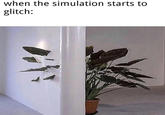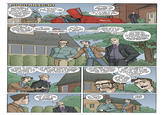About
Simulation Hypothesis, also known as the Simulation Theory, is the hypothesis that the universe, its inhabitants and other aspects of the physical world are simulated by a computer to a degree that is indistinguishable from our current conception of everyday reality. The concept of simulated reality and "ancestor simulations" have been commonly used as plot devices in works of science fiction.
Origin
In 1977, science fiction author Philip K. Dick discussed the possibility of the universe being a computer simulation while speaking at a science fiction conference in Metz, France.
In 1998, robotics and artificial intelligence researcher Hans Moravec published a paper titled "Simulation, Consciousness, Existence," proposing that our reality might actually be a simulation created by another civilization. In 2003, philosopher Nick Bostrom released a paper titled "Are You Living in a Computer Simulation?",[4] which included three propositions for determining the likelihood of the universe being a simulated reality:
1. "The fraction of human-level civilizations that reach a posthuman stage (that is, one capable of running high-fidelity ancestor simulations) is very close to zero", or
2. "The fraction of posthuman civilizations that are interested in running ancestor-simulations is very close to zero", or
3. "The fraction of all people with our kind of experiences that are living in a simulation is very close to one"
Spread
In 1994, writer Roger Williams released the online novella The Metamorphosis of the Prime Intellect,[5] in which an artificial intelligence rewrites the code of the universe to place humanity in a simulated reality. On November 17th, 2008, Xkcd[6] released a comic titled "A Bunch of Rocks," in which a stick figure creates a simulated universe on a planet (shown below, left). In February 2012, the webcomic Saturday Morning Breakfast Cereal posted a comic featuring a woman who calculates that our universe is the 61st simulation from the bottom (shown below, right).[2]


On February 21st, 2013, YouTuber Adam Ford uploaded an interview with Bostrom in which he explains his simulation argument (shown below, left). On August 5th, YouTuber Computerphile uploaded a video titled "What if the Universe is a Computer Simulation?", featuring physicist Phil Moriarty discussing the history of the simulation hypothesis (shown below, right).
On August 29th, 2015, YouTuber spumwack uploaded an animation based on the short story I Don't Know, Timmy, Being God is a Big Responsibility[3] (shown below). On October 6th, YouTuber Fair Wind Film uploaded a short documentary on the simulation hypothesis.
On February 19th, 2016, YouTuber LEMMiNO uploaded a video titled "Simulated Reality," in which a narrator explains various ideas related to the simulation hypothesis (shown below). Within five months, the video gained over 1.05 million views and 13,000 comments.
In Popular Culture
In 1999, the science fiction film The Matrix was released, featuring a computer hacker discovers much of humanity is living in a simulated reality while being held captive by robots in the real world (shown below, left). In 2001, the film Vanilla Sky was released, starring Tom Cruise as a man who enters a simulated reality after horribly scarring his face (shown below, right).
On January 13th, 2014, Season 1 Episode 4 "M. Night Shaym-Aliens!" of the show Rick and Morty was broadcast, in which a group of space aliens hold the characters Rick Sanchez and Jerry Smith as captives in a simulated reality (shown below). Additionally, similar themes have been explored in the films Inception and Tron, the comedy novels The Hitchhiker's Guide to the Galaxy, and various television series including Star Trek, The X-Files and Doctor Who.
Elon Musk's Code Conference Statements
On June 1st, 2016, the Recode YouTube channel uploaded a clip of Elon Musk discussing the simulation hypothesis during a question and answer session at the Code Conference, in which he revealed that he believes humanity is likely living in a simulated reality (shown below).
"The strongest argument for us being in a simulation probably is the following. Forty years ago we had pong. Like, two rectangles and a dot. That was what games were. Now, 40 years later, we have photorealistic, 3D simulations with millions of people playing simultaneously, and it's getting better every year. Soon we'll have virtual reality, augmented reality. If you assume any rate of improvement at all, then the games will become indistinguishable from reality, even if that rate of advancement drops by a thousand from what it is now. Then you just say, okay, let's imagine it's 10,000 years in the future, which is nothing on the evolutionary scale. So given that we're clearly on a trajectory to have games that are indistinguishable from reality, and those games could be played on any set-top box or on a PC or whatever, and there would probably be billions of such computers or set-top boxes, it would seem to follow that the odds that we're in base reality is one in billions. Tell me what's wrong with that argument. Is there a flaw in that argument?"
Search Interest
External References
[1] Cmu.edu – Simulation Consciousness Existence
[2] SMBC-Comics – Saturday Morning Breakfast Cereal
[3] Qntm – I dont know Timmy being God is a big responsibility
[4] Simulation-Argument.com – Are You Living in a Computer Simulation?
[5] Localroger – Metamorphosis of the Prime Intellect
[6] Xkcd – A Bunch of Rocks
Recent Videos 8 total
Recent Images 9 total
Share Pin


















Comments ( 79 )
Sorry, but you must activate your account to post a comment.
Please check your email for your activation code.